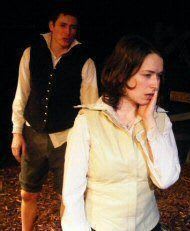This is a play that, when first published in 1608, was attributed to Wylliam Shakspeare, though it is probably more likely it was by someone else, possibly Thomas Middleton. It takes its plot from a real incident when a Yorkshire gentleman, William Calvery, murdered two of his children and stabbed his wife. He was hung for his crimes in 1605 and his story told that year in both a pamphlet and a ballad
The play does not name the family, the characters become just wife and husband, but its original audiences would no doubt have identified them with that particular gory piece of news. It is a crime that is difficult to credit but no isolated case, as anyone who reads their newspapers will know, making the voice over which this production adds to its final moments referring to a recent incident an unnecessary addition that blunts the ending without making any further point.
The husband accuses his wife of cuckolding him but there is no evidence that this is the case. We have already been told he beats her and this is probably just part of the abuse that he hurls at her. His anger comes from his lack of resources - he has drunk and gambled everything away. His brother, away at university, has guaranteed a debt and ends up in prison for it and when he sends his wife to ask for funds from her family and instead is offered a place at court to re-establish himself he seems bent on killing his children and probably himself rather than he or they should face the shame of penury. In Japan perhaps that might once have matched a code of honour but not here, not even in the early years of Jacobean rule, as is clear from its treatment as a sensational story.
This is not a melodrama but a play that seems to show real anguish, however misguided and however inexplicable the forgiveness of an ill-treated wife may seem to most people today, it is the same wifeliness as Shakespeare shows in Desdemona - and you only have to look at the behaviour of some modern of battered wives to see that it still persists. However, to make it work as it is presented here, it must be played with absolute sincerity. Charlotte Powell gives us a picture of dutiful devotion (no less than was expected by her society) but she is not yet entirely comfortable in the role - it is a sure sign when an actor keeps retreating backwards in a speech. With more stillness this is a performance that could grow.
As her husband Lachlan Nieboer doesn't quite pull it off. I imagine he is trying to show the weakness of the man but, though at times flushed with fury, this is in danger of being a weak performance. Clearly a lot of thought has gone into his phrasing but I never believed that his words were thought and fresh-minted until a touching moment when he held a baby before killing it and in his final speech of repentance which was deeply moving. Stephen Barden as a local magistrate, Vicky Gaskin as a nursemaid and Daniel Blacker as another household servant give strong support.
Director Andy Brunskill keeps all his cast on stage throughout, lined up against the rear wall and they are to be congratulated on they way they melt into the background and don't attract attention - but is it really necessary when it means they then have to walk out of the acting area to make an entrance through a token doorway? In a play where precise location really doesn't seem important we have signs displayed to name every location. They are not easy to read and seem to need at least two people to take down and put up between each scene which, along with any costume additions or hand props to be acquired, become part of a lengthy choreographed ritual between the often quite short scenes, needlessly jerking the action to a standstill.
Designer Amy Cook covers the floor with wood shavings which looks effective, though it makes it feel like a barn and they tend to stick to clothing when people fall or are forced to the ground. There are also half a dozen or so small metal-edged boxes which are re-arranged between each scene as furniture or to indicate door jambs. I am sure it helps the actors not to have to deliver the whole play standing but most of these boxes could be dispensed along with their constant rearrangements. With a tight budget in a small space it is always worth asking 'is it really necessary?' and the answer is often not just no but that doing without is better. Simplicity, like stillness, is often more effective, as with Cook's costumes: bare feet simple shirts, lace collars, waistcoats and trousers cut down to breeches, with skirt hoops worn over them for women, effectively suggest period costume without attempting to reproduce it.
Lawrence Carmichael has staged some effectively stylized fights and Brunskill has gone a long way towards making this production work. It is a play few people have read, let alone had the opportunity of seeing, and Tough Theatre does a service in mounting this production. It is a surprisingly short play compared with what we are used to in Jacobean drama and runs just over an hour. As a piece of docu-drama it could neatly fit a 50 minute television slot and on this evidence it could have had the same kind of appeal to the audiences who saw it first.
Until 24th January 2010
